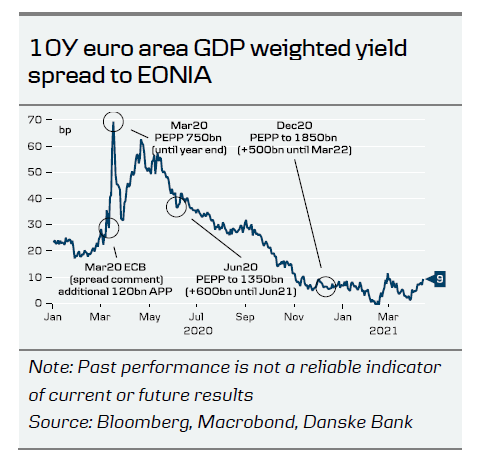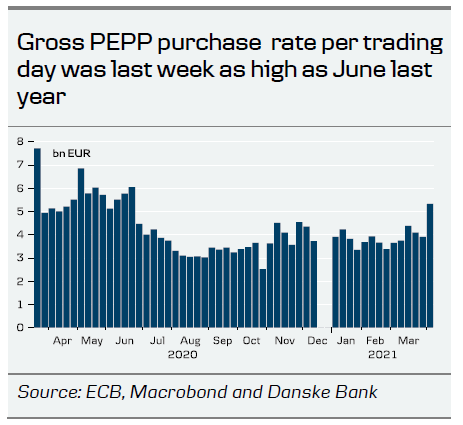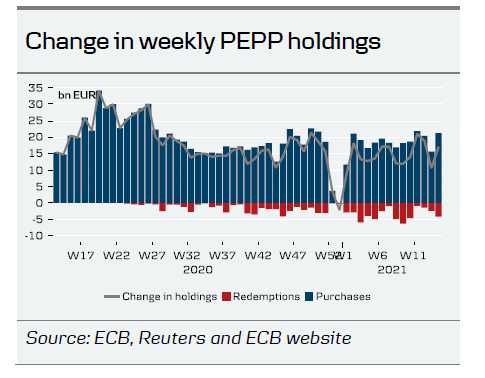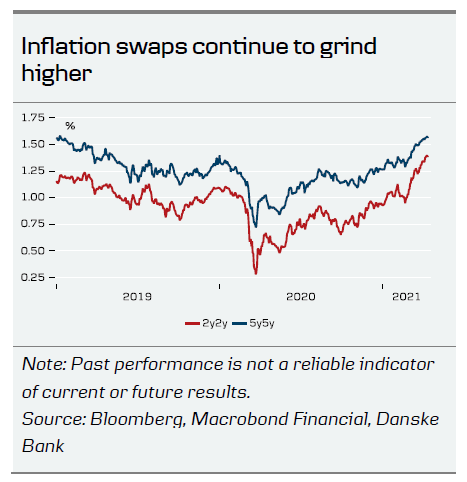The ECB meeting on Thursday next week will be a stock taking meeting with focus on the resilient economic data and positive outlook for coming months while Lagarde will face questions on the recent PEPP purchase behaviour. The PEPP data has only shown an uptick in gross purchase pace last week if corrected for number of trading days, well past the March meeting announcement.
We expect the growth outlook to be ‘broadly balanced’ paving the way for the PEPP purchase pace going back to February levels around EUR60bn after the June meeting. We think Lagarde will repeat the ‘delayed and not derailed’ recovery narrative.
While we expect the June meeting will conclude in a lower PEPP buying, the battle about PEPP’s future is set for September in our view. We read the ECB as a central bank that are slowly paving the way to exit the crisis response tools. Therefore, we expect ECB to end PEPP net purchases no later than March 2022, leaving reinvestments, net APP purchases and another round of TLTROs as the policy mix beyond March 2022.
We expect markets to trade mostly sideways through the press conference.
ECB more likely to end PEPP than extend
The recent rather muddled communication from GC members on the back of the March decisions, notably about how to view and assess the financing conditions, have led us to conclude that there are an internal split in the governing council about the future of the PEPP. The March minutes clearly showed in our view that the doves ‘won’ on paper while the hawks ‘won’ on substance. The minutes show that the ‘broad agreement’ for increasing the PEPP buying by a ‘significant’ amount ‘over the next quarter’ was conditioned that ‘the total PEPP envelope was not being called into question in the current conditions and that the pace of purchases could be reduced in the future.’ Furthermore, the ECB GC has a revealed preference for reviewing the overall stance of financing conditions on the inflationary outlook at the quarterly meetings, which also means that ECB is not here to micro-manage spreads or market levels.
Furthermore, we see the ECB as being a central bank that is not concerned about the level of interest rates. The minutes noted that the ‘risk-free rates and GDP-weighted sovereign bond yields had increased…’ yet the GC ‘… needed to avoid giving the impression of being overly focused on sovereign yields or reacting mechanically to a set of indicators of financing conditions’, while at the same time the minutes also say that rises in GDP weighted yield ‘needed to be pronounced and persistent in order to exert a material impact on broader financing conditions.’ This has led us to conclude that ECB is more likely to end PEPP net purchases than extend the package beyond March 2022. Finally, as ECB did not intervene during the market sell-off in late February using the flexibility within the PEPP programme, we find the bar for using additional bond buying pace beyond the current decision substantial. Ultimately, we judge that the ‘flexibility is very differently perceived by market participants than the ECB.
In sum, we expect ECB to be closer to ending net PEPP purchases than extending beyond March 2022. We still see the ECB policy stance as accommodative, even beyond March 2022. Our chart pack with preferred metrics also show an overall accommodative monetary policy stance, where updates of the BLS and the SPF will feed into the overall discussion on the monetary policy stance.
PEPP buying has only picked up last week – still plenty of envelope available
The March decision to conduct the PEPP purchases ‘over the next quarter’ at a ‘significantly’ higher volume are not up for discussion at next week’s meeting. We do not expect the picture shown in the weekly figures so far to be the picture of the higher volume. The net purchases has continuously fluctuated around EUR17-20bn/week, which are broadly unchanged from the weeks leading up to the March decision. However, if we adjust for number and trading days and redemptions, there are evidence that the most recent week (settlement until 9 April), was conducted at a EUR5.3bn gross purchases (chart on front page), which is at the highest level since June last year. We do not see expect the PEPP envelope to be questioned in size as ECB has conducted slightly less than EUR1trn of the EUR1.85trn.
Delayed, but not derailed economic recovery
The economic data that has been published since the March meeting support the ‘delayed but not derailed’ recovery narrative that ECB has pushed in recent weeks. While the lockdowns have been prolonged or re-introduced in a range of countries, business and consumer surveys suggest the euro area economy remains fairly resilient in light of the new headwinds. Manufacturing activity picked-up pace at the end of Q1, with German manufacturing PMI reaching a new all-time high of 66.6. The restrictions on the services sector continue to be a drag on growth, but the euro area composite PMI rose back into expansion territory at 53.2 for the first time since September, suggesting that a tentative recovery took shape in the euro area at the end of Q1. Upbeat business expectations in both the manufacturing and services sector, improving consumer confidence and a resilient labour market provide a solid backdrop for the recovery to accelerate in Q2, once vaccinations pick up pace and restrictions can be eased. However, despite our expectation for the manufacturing sector to lose some of its growth momentum in the coming months, as the Chinese slowdown in business activity is slowly feeding though, we expect ECB to shift to a broadly balanced risk assessment on the growth outlook at the April meeting.
We also expect the Bank Lending Survey and SPF to be important ingredients into the setting of the financing conditions. Those surveys will be released later this month, however the monthly data on the loan dynamics in the euro area have somewhat moderated in recent months. The most recent BLS showed an expected tightening bias across credit conditions in the euro area.
As regards the inflation outlook, headline inflation is still projected to peak around 2.2% in Q3 this year, to fall back in 2022. ECB should look through the transitory effects. We also note that market based inflation expectations continue to rise, with 5y5y reaching 1.57%, which is the highest since early 2019 straight after the ECB ended QE last time. We project core inflation to remain around 1% through 2022,
Cross asset reaction set to be muted
For EUR/USD, ECB is unlikely to be a key story at the moment. At the last meeting, ECB’s optimism did spill over but given also the recent rally in spot from 1.17 to nearly 1.20, we would argue there is less scope to turn the tactical story even more positive. On net, we think that optimism towards the euro area is well priced in to inflation- and earnings expectations as well as FX. That said, if the discussion on PEPP drives European yields higher, we could see some effect on spot fx too.



















